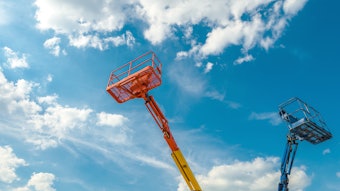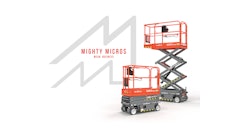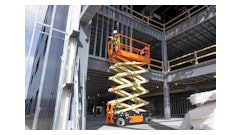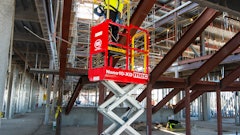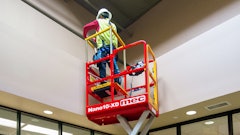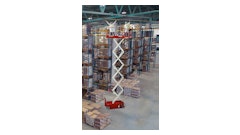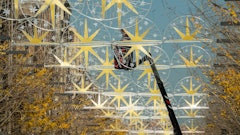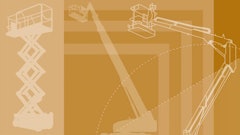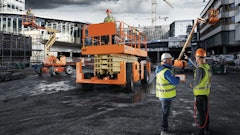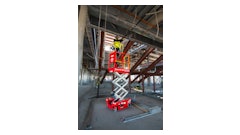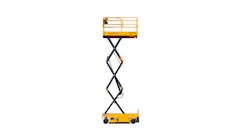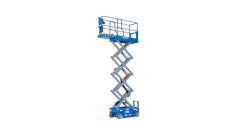
While boom lifts have long enjoyed an array of accessories to enhance their productivity, accessories available for scissor lifts - especially those included as standard equipment - have lagged a bit behind.
"Accessories for scissors haven't taken off yet like they have for boom lifts as far as their availability from rental houses," says Bill Dovey, JLG Industries. "But it's a growing market, and I think they will eventually take off because they can really make a machine more productive."
Within the past few years, that has become more evident. The list of options for scissor lifts has grown to include several accessories available a la carte or as packages designed specifically with an application - such as electricians, plumbers and plant maintenance personnel - in mind.
For example, many manufacturers offer pipe racks/cradles as a separate option. You can also find them included as part of packages such as the electrical contractor package offered by JLG. It includes key elements like conduit/pipe racks, electrician trees (wire spool loom) and a workstation that organizes battery-powered tools and includes a workbench for cutting materials, wiring light fixtures, etc.
Popular add-ons
Some of the most popular accessories for scissor lifts include:
Deck extensions - At one time, a deck extension was only an option on scissor lifts. But their ability to provide additional work space and up/over reach have made them so popular that today they are standard on most manufacturers' models.
"Deck extensions increase the productivity of the lift by adding the ability to reach out to obstacles that might otherwise be inaccessible," says Rafael Bazzarella, Skyjack. "In addition, extensions increase the usable workspace of any platform."
Some manufacturers are taking this feature to the next level by offering optional dual deck extensions to further increase platform space.
Pipe racks/cradles - This feature gives contractors off-the-deck storage for conduit or pipe, increasing the usable space on the platform and reducing trip hazards and worker's physical requirements. They also provide positive retention of materials during transport and installation.
Panel carriers - A panel carrier can be a boon to drywallers and panel installers. For example, the panel carrier on JLG ES scissor lifts consists of a trough mounted outside of the platform deck into which you can rest panels or sheets of drywall. It also features a bracket mounted above this trough to secure items and keep them from tipping away from the platform.
Platform power - Self-contained generators, inverters and air lines can be invaluable for powering tools while working at heights on the platform. A hydraulically driven generator mounted to a rough-terrain scissor lift can provide power in an area where there is none, notes John Norton, Genie.
Inverters, meanwhile, can convert DC power to AC power for electric scissor lifts, and air lines for electric and rough-terrain models make it possible to use compressed air.
Welders - An onboard quick welder such as the one offered by JLG is suitable for spot welding, and includes a self-contained feed welder.
"It saves time by eliminating the need to move bulky tanks, welding machines or cumbersome weld leads by integrating the welder and the leads on the scissor and utilizing the scissor batteries to power the welder," says Dovey. "With this option, you don't have welding leads draped over the railings, which can create safety concerns."
Options for uneven terrain - Optional outriggers provide a good solution for rough-terrain and DC scissor lifts working on uneven surfaces. Some manufacturers incorporate an auto level system for greater efficiency.
The active oscillation system offered by Genie is another option for improving productivity and safety in rough terrain. The dual-mode oscillation system features terrain-sensing technology that adjusts the axle position to maintain traction above the stowed position. This keeps all the wheels on the ground for maximum traction. "If you're going through rough terrain, it can sense the terrain and adjust accordingly," explains Norton.
Safety accessories - Flood lamps, flashing beacons and travel and tilt alarms can create a safer environment for workers on the platform and those on the ground. Floodlights provide illumination when working in areas where natural light is at a minimum. Flashing beacons visually let operators know when the machine is moving or in operation, while a travel alarm sounds a warning tone when the unit is in motion. Tilt alarms sound when you're working unsafely on uneven terrain.
Safety check
For any accessory, it's best to consider those approved by the manufacturer of your scissor lift. "The effects of these accessories to performance, functionality, capacity, stability and intended use require that each accessory be properly designed, tested and approved by the manufacturer," says Bazzarella. "Use of unapproved accessories can be dangerous."
"Check with your distributor if you want to add an accessory to make sure it's a proper one," advises Dovey. "If it's manufacturer approved, it will give you peace of mind. Contrived or homemade end user-provided devices sometimes used on aerial work platforms may or may not be properly designed and efficient for the intended purpose. They could contribute to a hazardous condition for the operator or surrounding personnel. So it's best to use only those approved by the manufacturer."
Scissor Lift Safety Tips
Add-on accessories can help to increase safety while operating scissor lifts. However, nothing replaces following the proper operating procedures.
In addition to reading the operator's manual and becoming certified in scissor lift operation, Arxcis trainer LeRoy LaMar advises scissor lift operators to double-check the following:
- Weight - Verify that the weight of individuals, tools and materials on the platform does not combine to exceed rated capacity.
- Load distribution - Check the operator's manual for load distribution requirements.
- Operator - For emergencies, designate a person to operate ground controls should the original operator become incapacitated.
- Path - Ensure the travel path is firm and level.
- Hazards - Survey the scene for hard-to-see overhead obstacles.
- Platform practices - Be sure platform workers know not to climb on rails, use ladders on the platform or push/pull objects outside the platform.
- Inspection - Confirm the pre-shift inspections have been performed, checking for the following:
- Ground and platform controls are labeled and functioning properly.
- Safety devices are operational.
- Batteries have adequate charge, fuel tank is full and fluids are at appropriate levels.
- No structural damage or worn parts exist.
- Tires are in good condition.
LeRoy LaMar can be reached at [email protected]. Arxcis offers The Hard Hat Training Series customizable training kits. For more information, visit www.hardhattraining.com.





